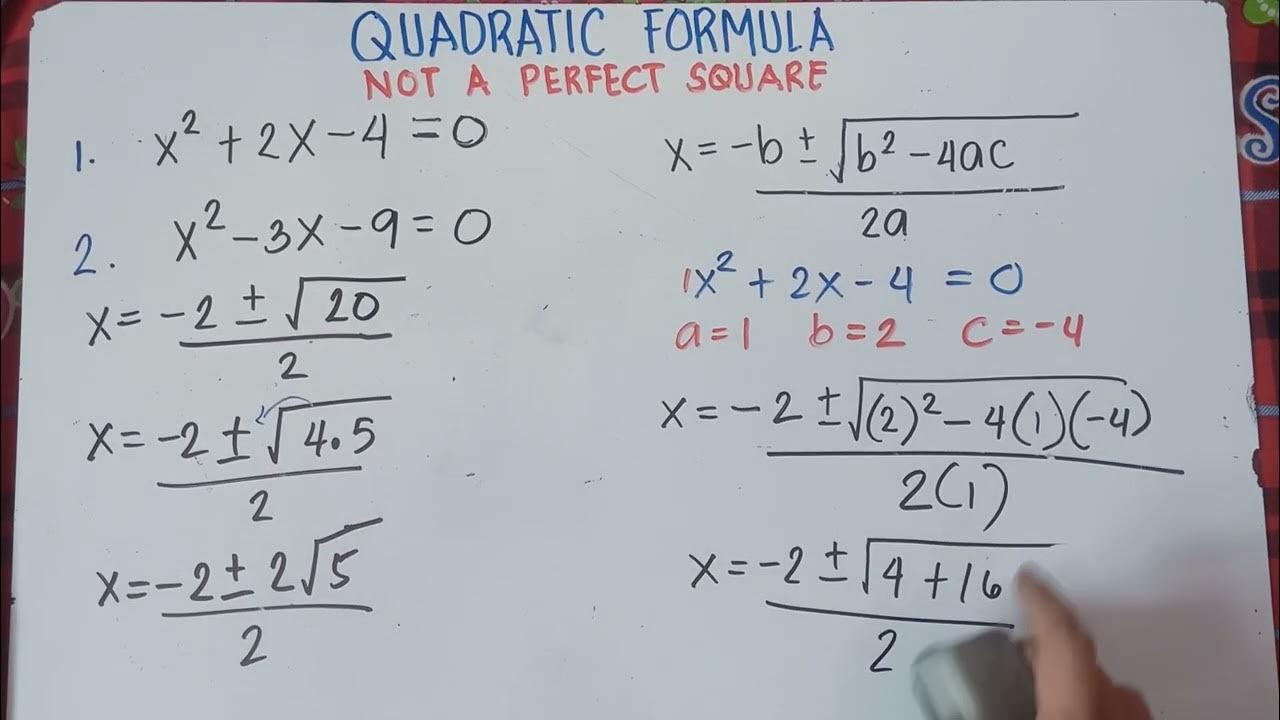THE NATURE OF THE ROOTS OF A QUADRATIC EQUATION USING THE DISCRIMINANT || GRADE 9 MATHEMATICS Q1
Summary
TLDRThis video explains how to evaluate the expression b² - 4ac, known as the discriminant, in quadratic equations. The discriminant helps determine the nature of the roots. If the discriminant is zero, the roots are real and equal. A positive discriminant, whether a perfect square or not, indicates rational or irrational roots, respectively, and if negative, the equation has no real solutions. Several examples illustrate how to substitute values for a, b, and c to calculate the discriminant and determine the type of roots for quadratic equations.
Takeaways
- 😀 The discriminant (b² - 4ac) is used to determine the nature of the roots of a quadratic equation.
- 😀 The quadratic formula is x = (-b ± √(b² - 4ac)) / 2a, where the discriminant is b² - 4ac.
- 😀 The discriminant helps determine whether the roots are real, rational, irrational, or nonexistent.
- 😀 If the discriminant equals 0, the roots of the quadratic equation are real and equal.
- 😀 If the discriminant is positive and a perfect square, the roots are real, rational, and unequal.
- 😀 If the discriminant is positive but not a perfect square, the roots are real, irrational, and unequal.
- 😀 If the discriminant is negative, the quadratic equation has no real roots.
- 😀 Example 1: For the equation x² - 4x + 4 = 0, the discriminant is 0, meaning the roots are real and equal.
- 😀 Example 2: For the equation x² + 7x + 10 = 0, the discriminant is 9 (a perfect square), indicating rational, unequal roots.
- 😀 Example 3: For the equation x² + 6x + 3 = 0, the discriminant is positive but not a perfect square, resulting in irrational, unequal roots.
- 😀 Example 4: For the equation x² + 2x + 5 = 0, the discriminant is negative, so the equation has no real roots.
Q & A
What is the discriminant in the quadratic formula?
-The discriminant is the part of the quadratic formula under the square root, represented as b² - 4ac. It helps determine the nature of the roots of the quadratic equation.
How is the quadratic formula structured?
-The quadratic formula is structured as x = (-b ± √(b² - 4ac)) / 2a, where 'a', 'b', and 'c' are the coefficients of the quadratic equation ax² + bx + c = 0.
What does it mean if the discriminant is zero?
-If the discriminant is zero, it indicates that the quadratic equation has real and equal roots.
How do you evaluate the discriminant for the values a = 1, b = 5, and c = 4?
-For a = 1, b = 5, and c = 4, substitute into the discriminant formula: b² - 4ac = 5² - 4(1)(4) = 25 - 16 = 9. The result is 9, which is a positive perfect square.
What is the result if the discriminant is a positive perfect square?
-If the discriminant is a positive perfect square, the roots of the quadratic equation are rational numbers, but not equal.
What does a negative discriminant imply for the roots of a quadratic equation?
-A negative discriminant implies that the quadratic equation has no real roots or solutions, meaning the roots are complex.
How do you determine if the roots of a quadratic equation are irrational?
-If the discriminant is positive but not a perfect square, the roots of the quadratic equation are irrational and not equal.
What does the discriminant tell us about the equation x² - 4x + 4 = 0?
-For the equation x² - 4x + 4 = 0, the discriminant is 0 (since (-4)² - 4(1)(4) = 16 - 16 = 0), indicating that the roots are real and equal.
What is the significance of the equation x² + 7x + 10 = 0 in terms of the roots?
-For x² + 7x + 10 = 0, the discriminant is 9 (a positive perfect square), meaning the roots are rational and unequal.
Why does the quadratic equation x² + 6x + 3 = 0 result in irrational roots?
-The discriminant for x² + 6x + 3 = 0 is 24, which is positive but not a perfect square. This means the roots are irrational and not equal.
Outlines

Dieser Bereich ist nur für Premium-Benutzer verfügbar. Bitte führen Sie ein Upgrade durch, um auf diesen Abschnitt zuzugreifen.
Upgrade durchführenMindmap

Dieser Bereich ist nur für Premium-Benutzer verfügbar. Bitte führen Sie ein Upgrade durch, um auf diesen Abschnitt zuzugreifen.
Upgrade durchführenKeywords

Dieser Bereich ist nur für Premium-Benutzer verfügbar. Bitte führen Sie ein Upgrade durch, um auf diesen Abschnitt zuzugreifen.
Upgrade durchführenHighlights

Dieser Bereich ist nur für Premium-Benutzer verfügbar. Bitte führen Sie ein Upgrade durch, um auf diesen Abschnitt zuzugreifen.
Upgrade durchführenTranscripts

Dieser Bereich ist nur für Premium-Benutzer verfügbar. Bitte führen Sie ein Upgrade durch, um auf diesen Abschnitt zuzugreifen.
Upgrade durchführenWeitere ähnliche Videos ansehen

MATH9 DISCRIMINANT and NATURE OF ROOTS of quadratic equation #math9 #discriminant #natureofroots

Nature of Roots of Quadratic Equations

Nature of Roots - Examples | Quadratic Equations | Don't Memorise

Jenis-jenis akar persamaan kuadrat || akar real berbeda, akar real sama, akar tidal real (IMAJINER)

Solving Quadratic Equations by Quadratic Formula | Not A Perfect Square | Part 2 |

Maths - EB11 - S - chap2 - v1 - polynomes et equation du second degre
5.0 / 5 (0 votes)
